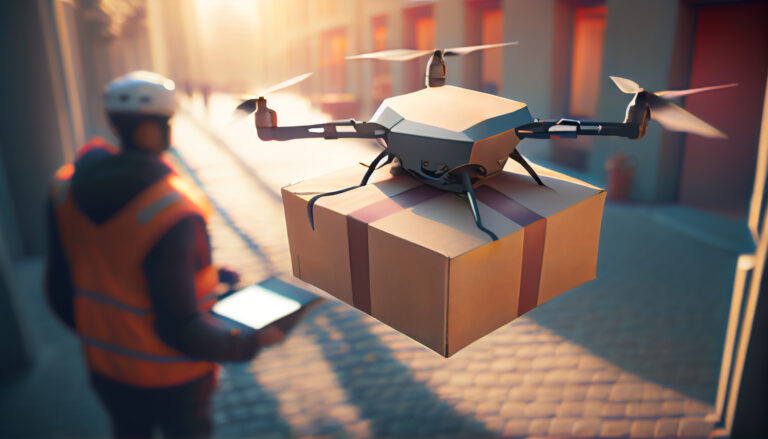In a world where speed and efficiency rule, and where parcel volumes have already reached eye-watering levels, Paul Willis asks whether there’s any scenario where aerial drone deliveries really make sense.
Amazon founder Jeff Bezos famously started the retailer in a rented garage in Washington state, going on to turn it into one of the biggest companies on the planet. Yet for a man who has made the seemingly impossible a reality, there is one dream he has yet to fulfill.
Ten years on from an interview with US broadcaster CBS, in which Bezos predicted that we were just four or five years out from last-mile drone delivery, his goal of populating the skies of our towns and cities with Amazon delivery drones still seems a long way off.
Although Prime Air, the Amazon offshoot launched in 2013, has succeeded in building a fleet of airborne drones, the scale of its operations has been modest to say the least. According to a report on US network CNBC, as of May 2023, Amazon had completed just 100 deliveries in two small US markets. However, the company has announced that it will bring drone deliveries to the UK and Italy next year, as well as a third location in the US.
Ian Kerr, founder and host of the Postal Hub podcast, is not surprised by the relative failure of the last-mile drone delivery dream, which he says has never made much economic sense. “There was this fantasy about drone delivery, that it would be liberating, fast and environmentally friendly,” says Kerr. “And the reality is that you’ve got this buzzing machine that delivers one thing at a time in the last mile, and that’s not a very efficient way to go about things.”
But while the Jetson-like dream (or nightmare) of parcel drones whizzing back and forth across the skies is yet to be realized, there certainly has been progress. Alphabet’s drone subsidiary, Wing, for example, claims to have made 330,000 deliveries, primarily in Australia, where it carries orders for supermarket chain Coles and online food delivery service DoorDash.
Earlier this year, US supermarket giant Walmart also announced that it is now operating 36 drone delivery hubs across the US via partnerships with several drone operators. Although Kerr is skeptical about many of the claims made on behalf of drone delivery, he by no means discounts the technology.
“There are use cases for drones, where the drone is the best way to deliver, or where it’s very difficult to deliver effectively or efficiently by any other means,” says Kerr. “I think that drone delivery has to find its niche, where it’s going to be effective and profitable and not a nuisance to the people who live near the flight path.”
Fit for purpose
As an example of one of those niches, he points to the US drone maker Zipline, whose aircraft are being deployed to carry blood and other essential medical freight in sub-Saharan Africa. In September, Zipline, which is one of Walmart’s drone partners, received clearance from the US Federal Aviation Authority (FAA) to fly beyond line-of-sight (BLOS) in US airspace, paving the way for the company to be able to make deliveries there.
Zipline recently unveiled a next-generation rotorcraft drone, but it’s important to note that until now most of its operations have been accomplished using a glider-like drone called the P1 Zip. Capable of 193km round trips, the P1 Zip’s fixed-wing design means that it requires a landing strip for take-off and landing. This landing requirement makes fixed-wing drones unsuitable for last-mile delivery. However, they use less energy than rotorcraft drones, which means they can be built bigger.
For postal and parcel companies, this opens the door to bulk, or middle-mile, drone delivery, a far more realistic prospect than last mile in the short to medium term, according to Chris Paxton, who heads the drone trial operations at the UK’s Royal Mail.
“Effectively, there are two use cases for UAVs [unmanned aerial vehicles] for parcel carriers: delivering to people’s actual addresses, and the bulk movement of mail. We’ve focused on the latter,” says Paxton. He gives two main reasons for this strategy. The first is a reluctance to replace the mail carriers who, as the face of last-mile delivery, remain “one of our biggest selling points”. The second reason is safety. “If you’re flying between two fixed points, you can obviously manage the risk a lot more easily than you can if you’re flying to multiple addresses.”
Remote trials
So far, Royal Mail has conducted four drone delivery trials, with a fifth ongoing this winter. All the trials have been on offshore UK islands that are difficult to access by conventional methods of transportation. The first trial took place in December 2020 on the Scottish island of Mull. Described by Paxton as “a proof of concept”, it involved drone delivery to a single address, a lighthouse on the island, which is a 30-minute walk away for the mail carrier.
Like other national posts, Royal Mail has a universal service obligation, which means that it is required to deliver mail to all UK addresses, no matter how remote. According to Paxton, this obligation puts postal companies such as Royal Mail “in a unique position to help move the [drone] technology on”.
Since the trial on Mull, Royal Mail has conducted trials on the Isles of Scilly off the southwest coast of England and the Orkney and Shetland isles off the north coast of Scotland. The most recent trial, which will run for three months this winter and is a collaboration with Skyports Drone Services, will deliver mail to the remote Orkney islands of Graemsay and Hoy.
“The parts of the UK that we’re operating in typically tend to get served by forms of transportation that were never designed for parcels,” says Paxton. In the case of Graemsay and Hoy, the islands are serviced by a passenger ferry that “doesn’t operate at times best suited to the Royal Mail network”.
The Royal Mail’s winter trial in the Orkneys will also be an opportunity to see how well the drones operate in bad weather, according to Paxton. The drones selected for the trial are Speedbird Aero rotorcraft with a payload capacity of 6kg and a range of up to 16km. The rotorcraft drones have been chosen because there are no suitable landing strips for fixed-wing craft on Graemsay and Hoy.
According to Paxton, part of the purpose of the recent trials has been to “focus the minds” of drone developers on the business case offered by parcel delivery. “A lot of these companies have looked at moving passengers and that has been their primary focus, but through the work we’re doing and others are doing, they’re now pivoting toward cargo because they’re realizing there are opportunities there.”
Maximum payload
For a full rollout of the technology, Royal Mail envisages partnering with drone operators, reveals Paxton. One possible partner could be Dronamics, a Bulgarian venture that bills itself as the world’s first cargo drone airline. The company has developed its own cargo drone, a fixed-wing prop-driven aircraft called Black Swan that is capable of carrying a payload of 350kg, equivalent to 3.5m3 – “The exact same capacity as a courier van,” according to Severina Grozeva-Patrone, communications director for Dronamics.
Dronamics has been granted a Light UAS operator Certificate (LUC) by the European Aviation Safety Agency (EASA) and is therefore licensed to operate in Europe. According to Grozeva-Patrone, the Black Swan was “specifically built to have a lower cost of manufacturing and operation, to be very cost competitive”.
Dronamics plans to operate the drone in geographies similar to the Royal Mail’s Scotland trials and the craft has been customized accordingly. “It’s built to be able to land nearly everywhere; it only needs 400m of terrain and that can be unpaved,” says Grozeva-Patrone. “The idea is that you can go to remote places that don’t have a full-service airport.”
With this in mind, Dronamics’ anticipated first market is the Greek islands, from where it plans to expand operations to the rest of Europe. According to Grozeva-Patrone, the company hopes to partner with postal and freight companies. In October 2023, it signed a letter of intent (LOI) with Emirates Post to explore cargo drone capabilities for same-day middle-mile and long-range deliveries in the UAE. Elsewhere, in August 2023 Dronamics announced a partnership with NHS Scotland as part of a project to deliver essential medical supplies to remote Scottish communities.
Rather than being fully autonomous, the Black Swan, which is about the size of a two-seater Cessna, is operated remotely by a pilot based inside a support van. Given the aircraft’s size, it could feasibly have been operated by an onboard pilot. But, “Once you put the person in the aircraft, the specs become completely different,” says Grozeva-Patrone.
“If there are no humans on board and it’s just the freight and avionics of the aircraft, it can be really optimized to carry cargo,” she says. Not having an onboard pilot also makes it simpler from a logistical perspective, she says, because, “You’re not moving humans to these remote places each day.”
For remote operations such as sparsely inhabited islands, Dronamics plans to recruit local staff to take care of the cargo operations. Grozeva-Patrone says that the decision to opt for bulk cargo delivery rather than last mile seemed the most practical choice, especially in Europe where urban centers tend to be heavily built up with few available landing sites. “I don’t know if middle mile is easier in terms of operational setup,” she concludes, “but it definitely feels more realistic.”
This article was originally published in the December 2023 issue of Parcel and Postal Technology International.



